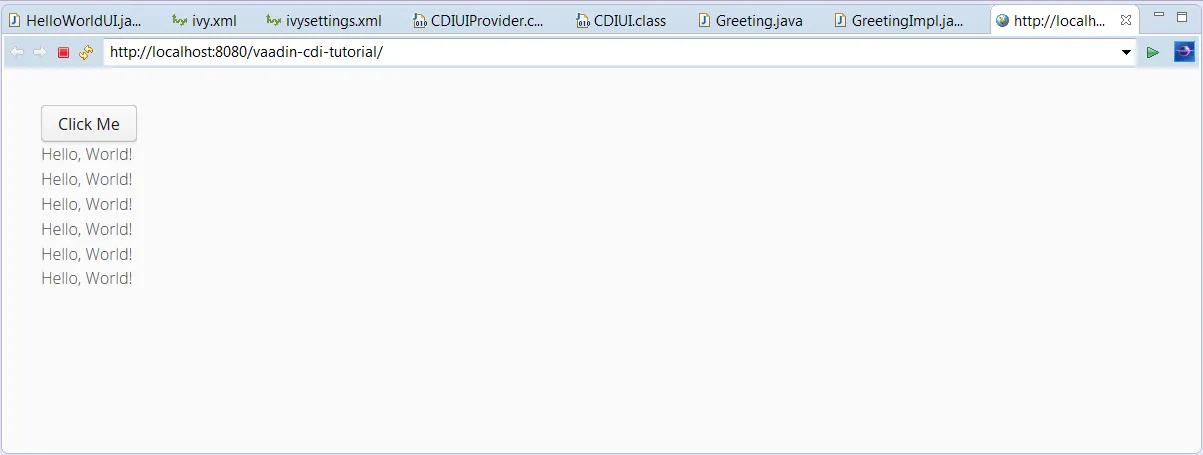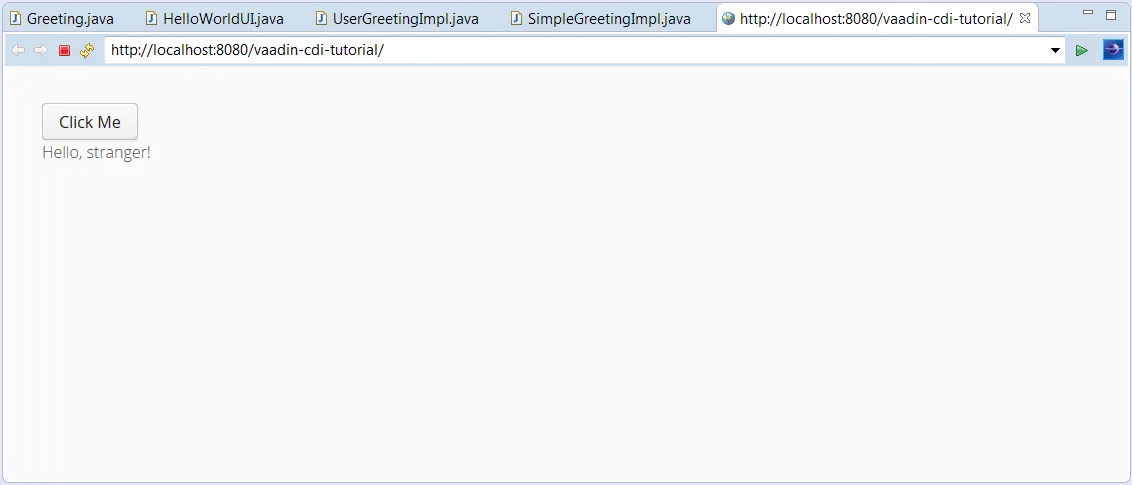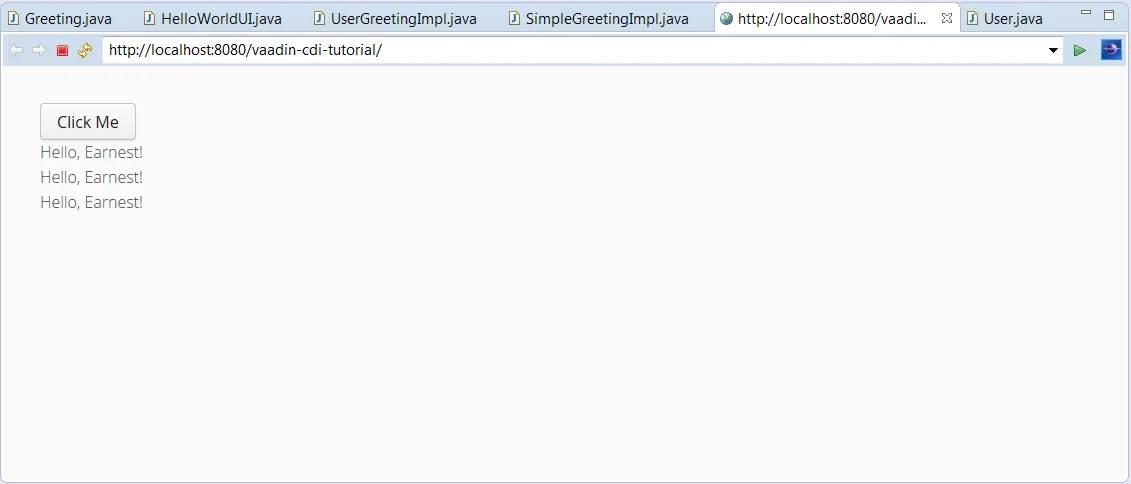II - Injection and scopes
In this tutorial we’ll take a closer look at the @CDIUI annotation and use CDI to inject some beans to our application.
@CDIUI
The @CDIUI annotation is the way in which you let the Vaadin CDI plugin know which UI’s should be accessible to the user and how they should be mapped. It accepts one optional String parameter indicating the UI path. If an explicit path is not provided the class name of the UI will be used to construct a pathname by the following convention: any trailing "UI" will be truncated and camelcase will be converted to hyphenated lowercase. Some examples of the convention:
HelloWorldUI → hello-world ExampleUI → example VisualEditor → visual-editor
Passing an empty String as the path will cause the UI to be mapped to the root of the deployment. Most single UI applications will probably want to do this.
Injecting beans
Now that the UI itself has been injected, we can use the @Inject annotation to further inject beans to it. Let’s create something for us to actually inject.
We’ll define the following interface, and an implementation for it.
Source code
Java
package com.vaadin.cdi.tutorial;
public interface Greeting {
public String getText();
}Source code
Java
package com.vaadin.cdi.tutorial;
import java.io.Serializable;
public class SimpleGreetingImpl implements Greeting, Serializable {
@Override
public String getText() {
return "Hello, World!";
}
}So far so good, now we’ll inject it into our UI. You’ll need to add the CDI API as a dependency in your pom.xml. (Group id: javax.enterprise, artefact id: cdi-api, version: 1.2)
Source code
Java
package com.vaadin.cdi.tutorial;
import javax.inject.Inject;
import com.vaadin.annotations.Theme;
import com.vaadin.cdi.CDIUI;
import com.vaadin.server.VaadinRequest;
import com.vaadin.ui.Button;
import com.vaadin.ui.Button.ClickEvent;
import com.vaadin.ui.Label;
import com.vaadin.ui.UI;
import com.vaadin.ui.VerticalLayout;
@SuppressWarnings("serial")
@CDIUI("")
@Theme("valo")
public class HelloWorldUI extends UI {
@Inject
private Greeting greeting;
@Override
protected void init(VaadinRequest request) {
final VerticalLayout layout = new VerticalLayout();
layout.setMargin(true);
setContent(layout);
Button button = new Button("Click Me");
button.addClickListener(new Button.ClickListener() {
public void buttonClick(ClickEvent event) {
layout.addComponent(new Label(greeting.getText()));
}
});
layout.addComponent(button);
}
}Let’s run that and see.

So far so good. Suppose we want to say hello to the user by name. We’ll create a class to store our user data in. For now it’s a simple POJO just for storing the name in a single string.
Source code
Java
package com.vaadin.cdi.tutorial;
import java.io.Serializable;
public class UserInfo implements Serializable {
private String name;
public UserInfo() {
this.name = "stranger";
}
public UserInfo(String name) {
this.name = name;
}
public String getName() {
return name;
}
public void setName(String name) {
this.name = name;
}
}We’ll inject that to the UI and assign the user some name during initialization (for now)
Source code
Java
@Inject
private UserInfo user;
@Override
protected void init(VaadinRequest request) {
...
user.setName("Ernest");
}Then we’ll create a new implementation of the Greeting and inject the user there as well.
Source code
Java
package com.vaadin.cdi.tutorial;
import javax.inject.Inject;
public class UserGreetingImpl implements Greeting {
@Inject
private UserInfo user;
@Override
public String getText() {
return "Hello, " + user.getName() + "!";
}
}Now, it would be easy to think that that’s all you need but we’re not
quite there. There are two issues with this that need to be addressed.
The first one will become immediately obvious when you try to deploy the
application. The deployment will fail as the injection in HelloWorldUI
is ambiguous, that is CDI doesn’t know which implementation of Greeting
we want.
There are three annotations that are useful in situations like this:
@Default, @Alternative and @Specializes. Giving a bean any of these
annotations will affect it’s preference order when the CDI container is
looking for which implementation to inject. Unless otherwise specified,
beans will be considered to have the @Default annotation. Beans with the
@Alternative annotation will only be injected if that particular bean is
named in the beans.xml file (TODO: add link). Beans with the
@Specializes annotation will be considered a drop-in replacement for
it’s superclass, and will be used over any implementations it extends.
In our case, we’ll want to give SimpleGreetingImpl the @Default
annotation and UserGreetingImpl the @Alternative annotation.
Source code
Java
@Default
public class SimpleGreetingImpl implements Greeting {Source code
Java
@Alternative
public class UserGreetingImpl implements Greeting {After that the application could actually be deployed. To tell CDI we’ll want to use our alternative implementation we need to create the beans.xml in our WEB-INF folder, and add the following declaration to it:
Source code
XML
<beans>
<alternatives>
<class>com.vaadin.cdi.tutorial.UserGreetingImpl</class>
</alternatives>
</beans>Let’s try that out:

Better, but not quite there yet. We’re getting the wrong username, despite the fact that we set the username to "Earnest" in the UI. The problem here is the scope of the bean. If you don’t specify a scope for your bean either in the bean class itself or at the injection point, it’ll default to using the dependent scope. Every time you inject a dependent bean you’ll get a new instance, which is clearly not what we want here. Let’s go back to our UserInfo class and assign it an explicit scope.
Source code
Java
import com.vaadin.cdi.UIScoped;
@UIScoped
public class UserInfo {
...The @UIScoped annotation is specific to Vaadin CDI. Anything injected
with that annotation will get the same instance while within the same
UI. Load a different UI and you’ll get a different instance. If the
session expires or the UI is closed the instances will be cleaned up.
Let’s see if it worked.

Looks like we’re making progress.